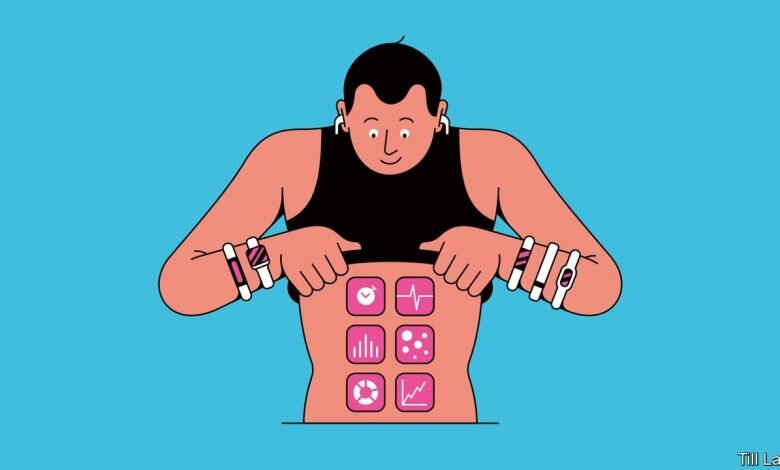Wearable technology promises to revolutionize health care

This is a stealthy killer. When the chambers of the heart get out of sync, blood can pool and form clots. Atrial fibrillation causes over a quarter of 100,000 strokes in the UK each year. Most of them will never happen if the heart arrhythmia is treated, but it has to be detected first. Tests are expensive and inaccurate, but Apple Watches, and soon Fitbits, may detect it, are much cheaper and could save people whose lives are in danger.
This is just one example of the revolution to transform medicine. A rapidly growing array of smartwatches and rings, fitness trackers and electronically advanced straps, patches and other “wearables” can record more than 7,500 physiological and behavioral variables. Some of them are more useful than others, obviously, but, as our Technology Quarterly explains in this issue, machine learning filters a torrent of data to reveal a consistent, quantifiable picture of you and your health. can.
These are early days for quantitative itself, and it’s still a wild ride for investors in digital health. Witness the recent drop in the share price of online consulting provider Teladoc, a worrying sign for other potential disruptions. But innovation in wearable devices for patients has only just begun. Individual firms may come and go, but wearables and artificial intelligence are poised to transform health care in three big ways: early diagnosis, personalized treatment, and management of chronic disease. Each promises to reduce costs and save lives.
Start with an early diagnosis. Wearables can detect subtle changes that would otherwise go unnoticed, leading to less severe disease and cheaper treatments. Sensors will reveal if an older person’s balance has started to weaken. In early-stage Parkinson’s, people’s gait and arm tremors are altered. Strength exercises can help prevent falls and broken limbs. Psychiatric diagnosis could be enhanced by tracking smartphone use patterns – without monitoring what people see or type. A smart ring can help a woman conceive by predicting her menstrual cycle. It can detect pregnancy less than a week after conception (many women continue to drink or smoke for weeks before realizing they are pregnant).
Then there’s the promise of seeing people as individuals, not theoretical, clones of the average human. Most drugs only work in 30-50% of patients. In a person, eating bananas regularly regulates blood sugar. In another, it elevates blood sugar to a level that can cause damage over time. Algorithms can transform the ream of data from wearables into bespoke prescriptions and diets to lose weight, control diabetes, and more. These arrangements are more effective, less limited and therefore easier to follow than one-size-fits-all types. When doctors can see a patient’s body in real time at all times, they can provide better care. Such monitoring of heart failure patients in a German trial reduced mortality and days spent in hospital by a third.
And wearables may replace chronic diseases like diabetes. About 80% of the disease is preventable by changing the way people live their lives. Apps use smaller devices and the kind of clever tactics employed by a personal trainer or a smarter spouse to get people to move more, eat better, and sleep more soundly. Even a small increase in exercise is good: adding 1,000 steps (0.7 km) a day reduces mortality by 6-36%, depending on how sedentary you are. Continuous monitoring also shifts the balance of care, from what physicians can do in brief occasional office consultations, to what patients can do for themselves on a day-to-day basis. The US spends $10,000–20,000 per year per diabetic patient and about $280bn nationally, which is half of the entire public-school budget. A diabetes-control app has been shown to reduce the cost per patient by as much as $1,400-5,000.
The scale of all these benefits promises to be huge. As wearables make up the data, leading to innovation, just how vast will become apparent. The reason for optimism is that the technology is ripe. Some 200m devices were sold in 2020 and twice that are expected to be sold in 2026. One in four Americans own a wearable device. Smartphones act as a platform for innovators. Within a year or two the device on your wrist may non-invasively measure your blood sugar, alcohol and hydration, as well as various markers of inflammation, kidney and liver function — all of which are currently required to remove blood. is needed. As wearables get more features, users are less likely to lose interest in them and be pushed to the back of a drawer.
Like any technology, wearables bring concerns. Health data are valuable; They can be misused by equipment-makers, insurers or governments interested in social control. Technology may not reach the poor and those who lead chaotic lives – the people who need it the most. But the biggest worry is that the health care bureaucracy gets in the way.
The market has the first responsibility to move forward. And developers are actually starting to pay for rigorous studies that demonstrate the safety, efficacy and value of their technology. A cottage industry that ranks devices and apps based on clinical efficacy and privacy is helping doctors, insurers and governments go from good to bad.
But health care professionals also have an important role to play. Health care is a conservative industry—and well, given the stakes. Yet it risks slowing the pace of digital medicine not because of legitimate concerns about safety, but because of the inertia of regulators, standards bodies, insurers and medical schools.
one app a day
Rules are needed to make data proprietary and use more transparent, so that people can understand and control what happens to their information. Standards can help developers build usable devices. Patients’ data needs to be tied into medical-record systems, which are often clumsy. Physicians need treatment protocols to use the new technology. Doctors must be trained and reimbursed to offer digital treatments and review data. Governments and insurers must work on how to build technology into subsidized health care systems so busy fighting fires that they struggle to invest in prevention.
This is a long and challenging list. But the payoff, in wealth and welfare, has the potential to be much larger. Time to roll up the sleeves and prepare health care for the era of the quantitative self. I




